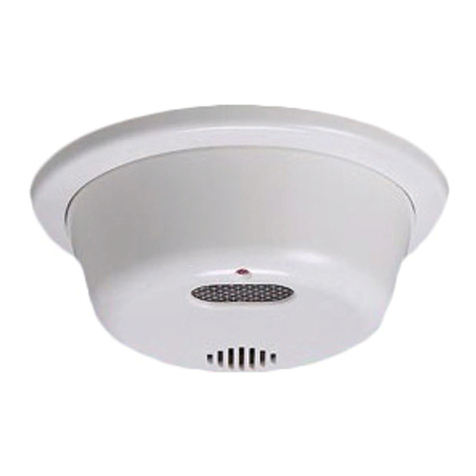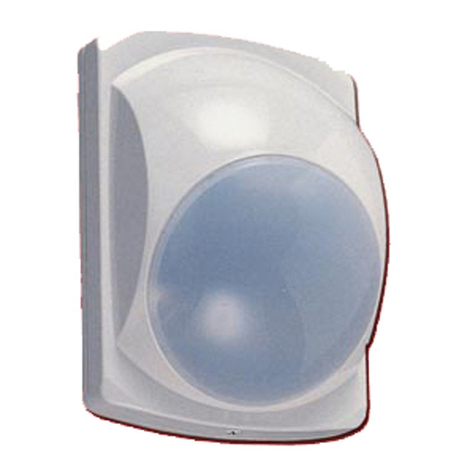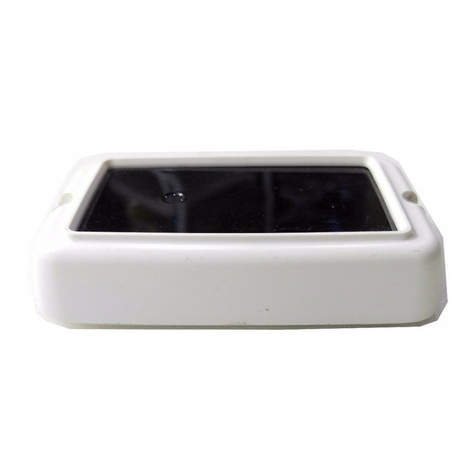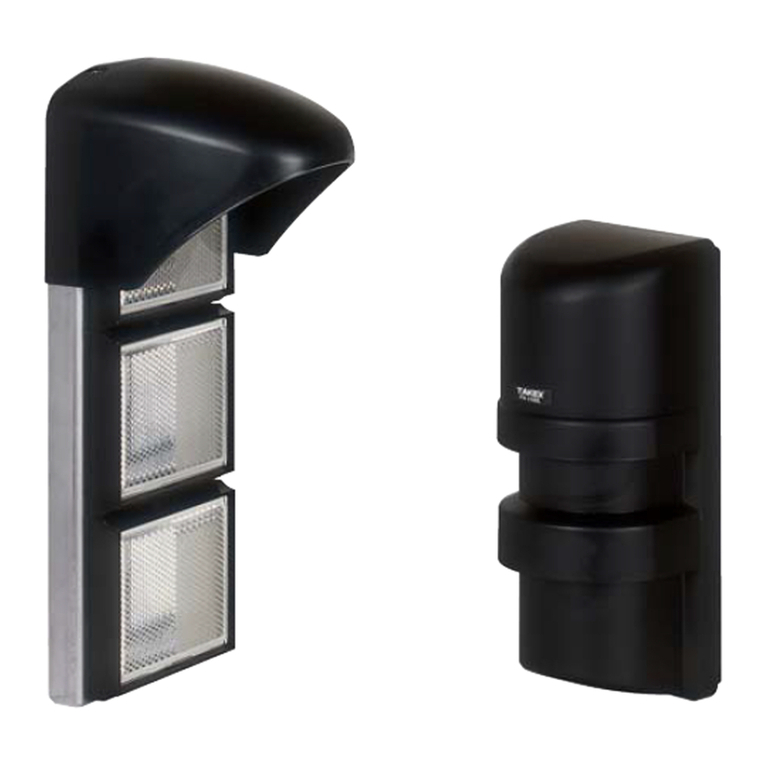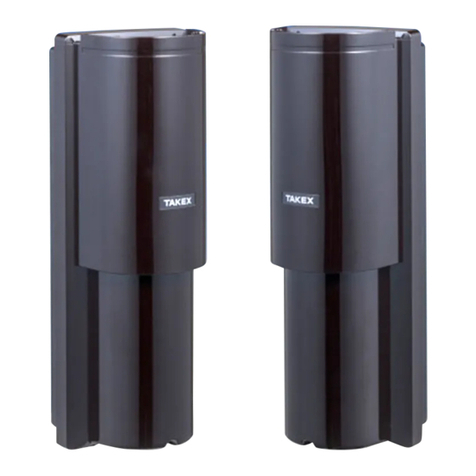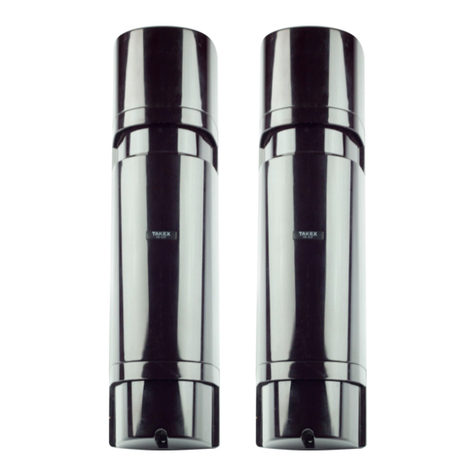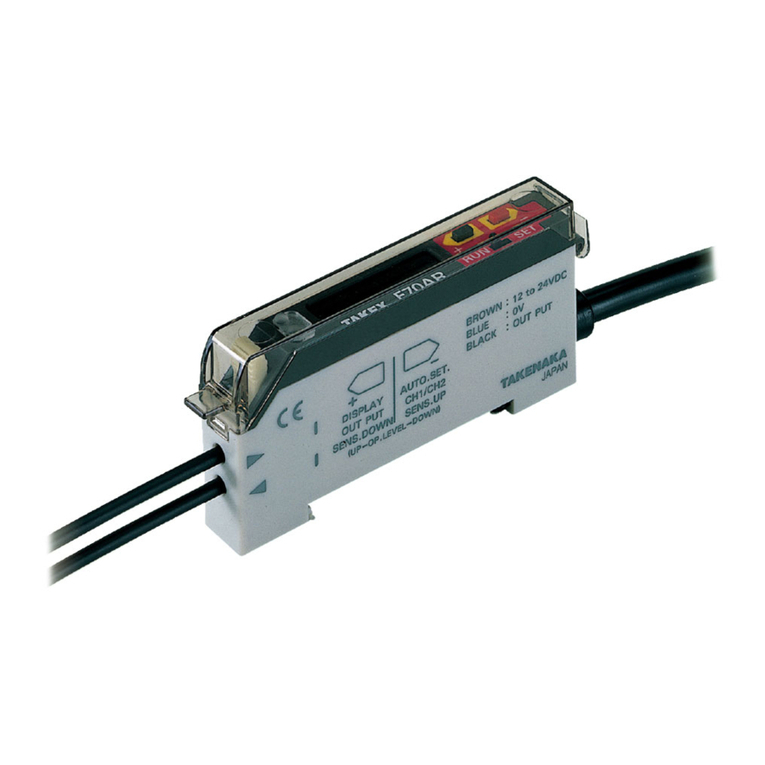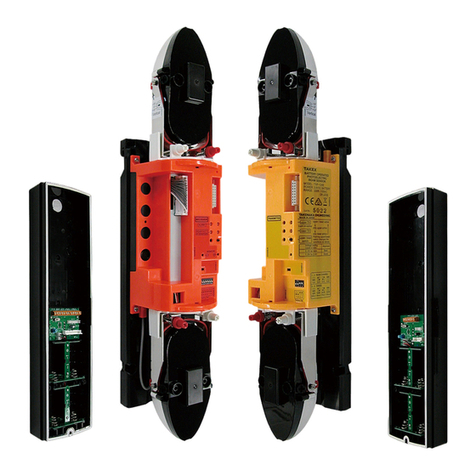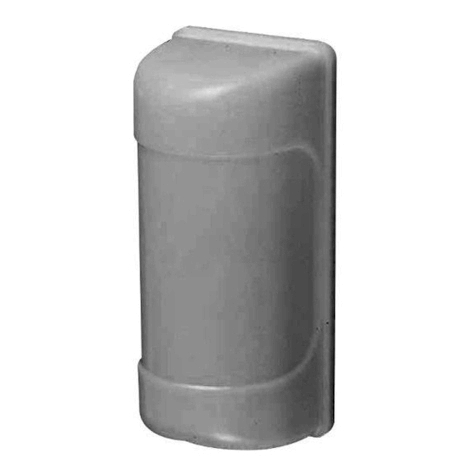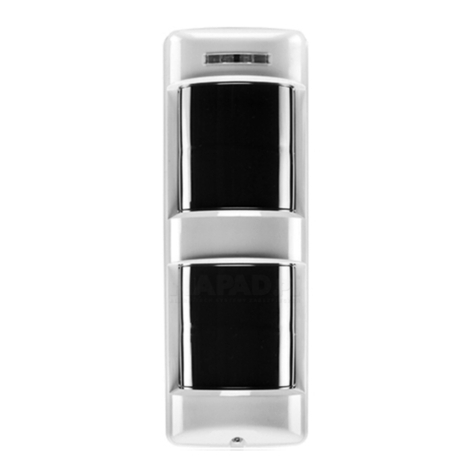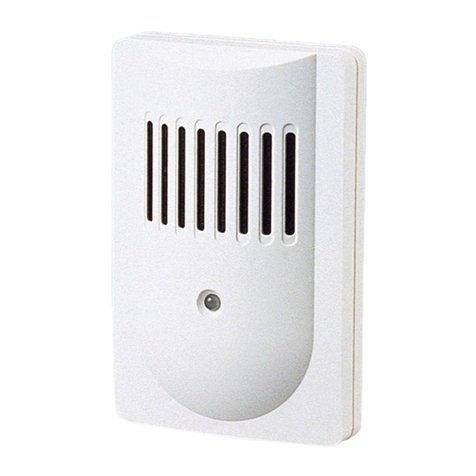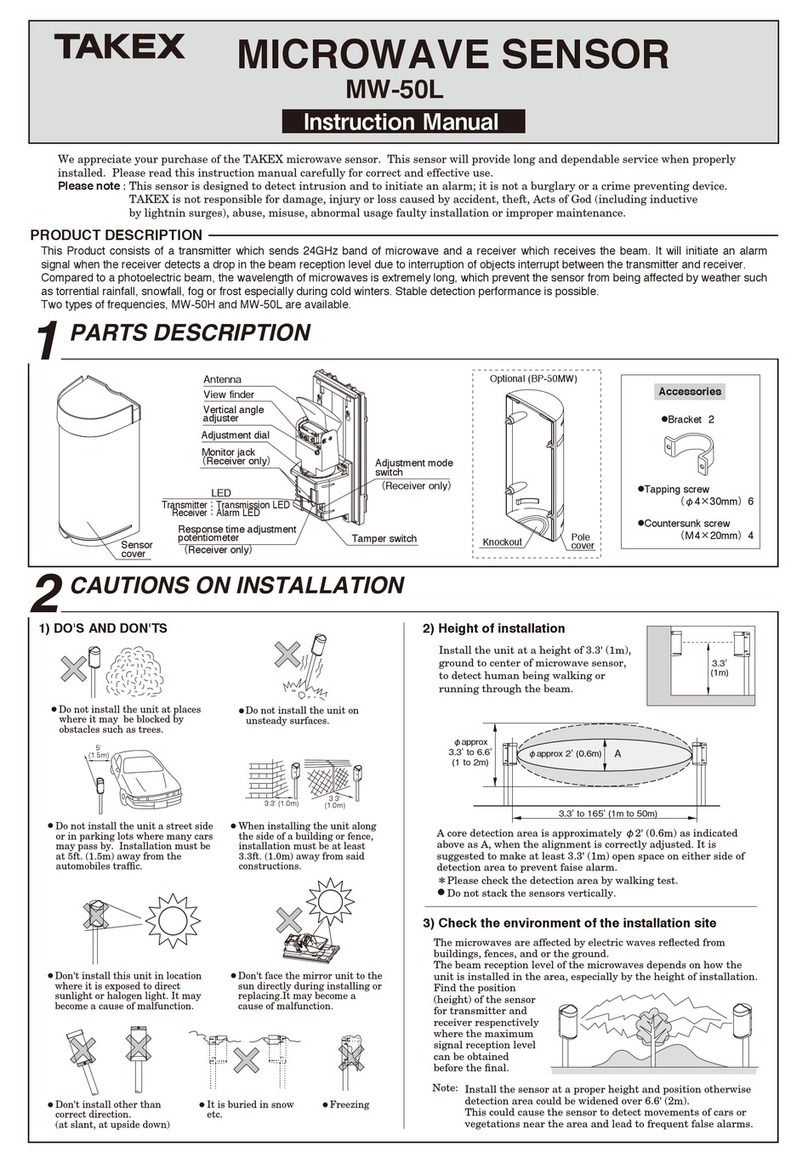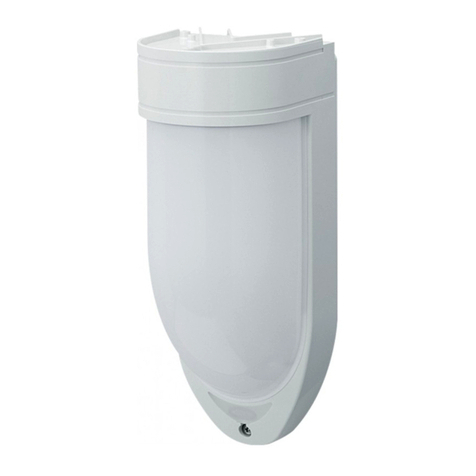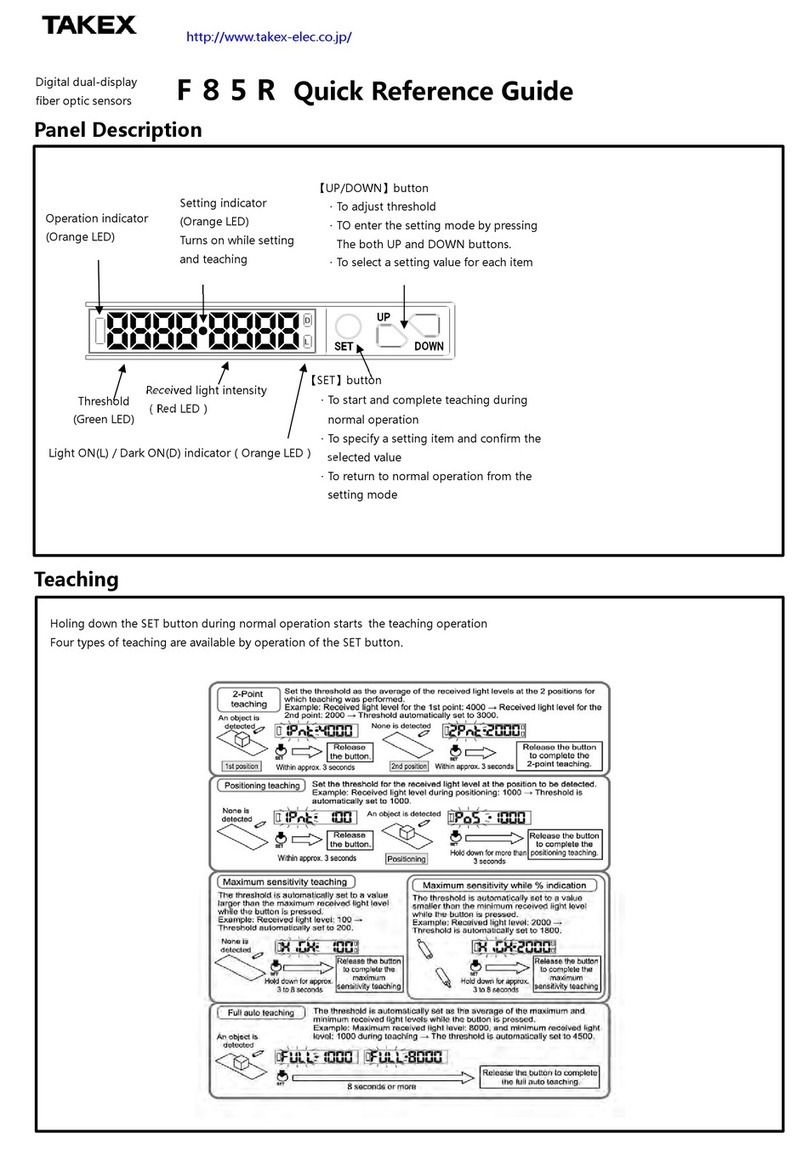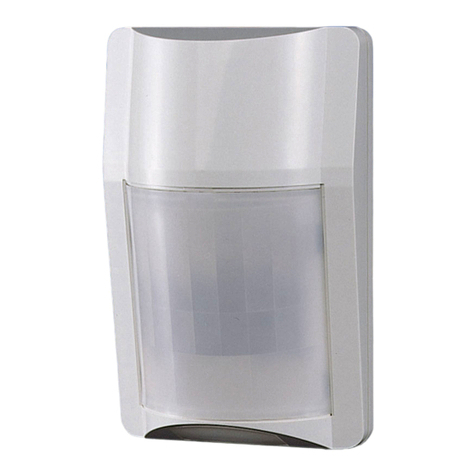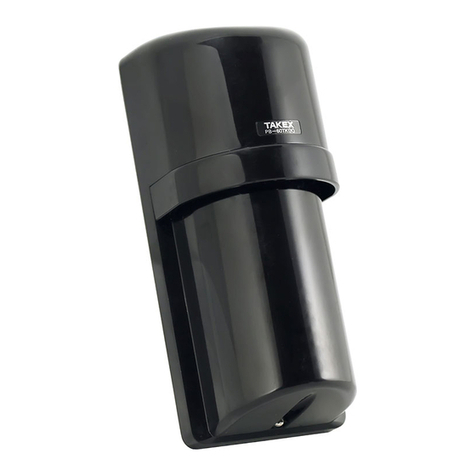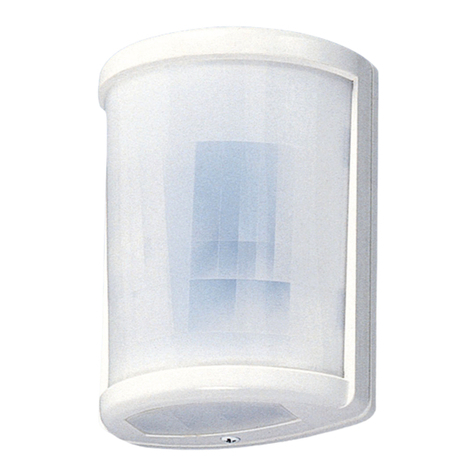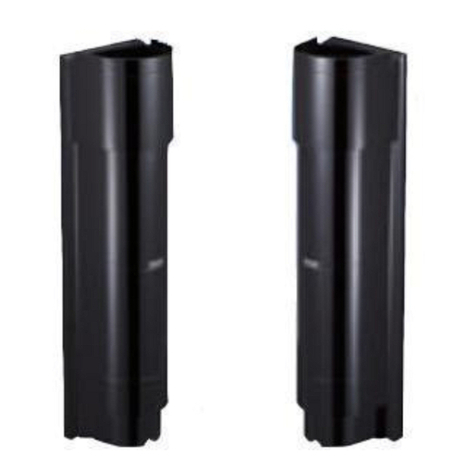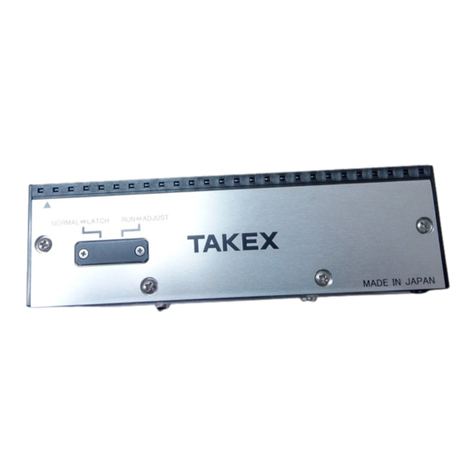8
Manual de instrucciones TX-114TR/114FR/114SR
Le agradecemos que haya adquirido un sensor de
infrarrojos pasivo TAKEX. Instalar correctamente
este sensor proporcionará una larga vida útil de alta
fiabilidad. Por favor, lea detenidamente este manual
de instrucciones para un uso correcto y efectivo.
Atención:
Este sensor está diseñado para detectar intrusiones e
iniciar una alarma; no es un dispositivo de prevención
de robo. TAKEX no se hace responsable por daños,
lesiones o pérdidas ocasionados por accidentes,
robos, desastres naturales (incluyendo las cargas
inductivas causadas por relámpagos), abuso, mal uso,
uso anormal, instalación defectuosa o mantenimiento
inadecuado.
DESCRIPCIÓN DEL PRODUCTO
TX-114TR/TX-114FR/TX-114SR es un sensor de
infrarrojos pasivo de bajo consumo de corriente,
diseñado para ser equipado con un transmisor
inalámbrico en su parte trasera.
Confirme que esta unidad coincida con el trans-
misor a utilizar.
Algunos transmisores podrían no percibir las
emisiones de esta unidad.
1) Este sensor está equipado con una detección
"AND" y un sistema contador de impulsos, el cual
mejora la fiabilidad del sensor al utilizarse en un
entorno exterior severo.
2) El sistema de detección AND emitirá una señal de
alarma únicamente al producirse la detección en
las zonas horizontal y baja simultáneamente.
3) El sensor está equipado con interruptores anti-
sabotaje trasero y delantero.
El interruptor anti-sabotaje delantero emite una
señal al extraer la tapa de la unidad.
El interruptor anti-sabotaje trasero emite una
señal cuando toda la unidad es extraída de la pared
o barra de instalación.
2PRECAUCIONES
•El LED operacional parpadea durante aproximada-
mente 1 minuto al encender la alimentación.
Durante este período de precalentamiento, el
sensor no detecta.
•No derrame agua sobre esta unidad con una man-
guera ya que está diseñada para soportar la lluvia
no está hecha a prueba de agua.
•Cuando el modo de detección está ajustado al modo
AND, este sensor emite una señal de alarma única-
mente si tanto el sensor inferior como el superior
detectan objetos.
En otras palabras, no realizará la detección en
el área no cubierta por los sensores superior e
inferior.
[Únicamente aplicable a TX-114FR]
•El suministro de alimentación es únicamente una
batería alcalina o de litio.
•El suministro de alimentación necesita poseer el
mismo voltaje o superior que el del transmisor.
[Zona de detección]
(El área cubierta por el
sensor superior e inferior)
Cobertura del sensor
inferior (sin detección)
Cobertura del sensor
superior (sin detección)
3ZONA DE DETECCIÓN
La zona de detección de esta unidad consiste de una
zona horizontal y una zona baja.
La señal de alarma es emitida únicamente cuando
ambas zonas de detección detectan objetos.
La distancia de detección puede ser configurada por
el ajuste del ángulo de la zona baja.
TX-114TR/114SR está equipado con 1 juego de senso-
res en el lado superior.
TX-114FR está equipado con 2 juegos de sensores
en el lado superior y en el inferior, posibilitando
seleccionar el modo AND o el modo OR.
A. La señal de alarma es emitida únicamente
cuando ambas zonas de detección, horizontal y
baja, detectan objetos.
B. No detecta pequeños animales que probablemen-
te no alcanzarán la altura de la zona horizontal.
C. No detecta vehículos moviéndose en el área
exterior del rango de la zona baja.
MODELO DE COBERTURA
[Detección de ángulo ancho]
(1) Apunte el sensor al centro del área a detectar.
Girando el sensor hasta un máximo de ±45°, podrá
detectar todas las zonas delante del mismo.
Al girar la unidad más de ±45°, las zonas de
detección serán eliminadas una a una desde el
extremo.
(2) Consiste de siete zonas de detección.
(Ancho de ángulo: 90°)
(3) Utilice lámina de enmascaramiento de área adjun-
ta al eliminar zonas de detección.
[Detección de pared]
(1) Coloque la lámina de enmascaramiento de área en
el soporte de la lente (en el interior de la tapa) sin
cortarla.
(Consulte el enmascaramiento de zona para
averiguar cómo adherir la lámina al soporte de la
lente.)
(2) Gire el sensor 90° y colóquelo delante de la direc-
ción a detectar.
(3) Ajuste de precisión horizontal
El ajuste de precisión puede hacerse dentro de un
rango de ±3°, por si acaso existen obstáculos en
la pared.
(La zona de detección se desplaza aproximada-
mente 2' (0,6 m) en un rango de 40' (12 m).)
Deslice la palanca hacia la izquierda o derecha.
AJUSTE DE ÁREA [Ajuste horizontal]
•Asegúrese de que la palanca esté ajustada a 0° para
la detección horizontal.
·Al alejar la zona de detección de la pared, deslice la
palanca hacia la pared.
·Al acercar la zona de detección a la pared, deslice la
palanca en dirección contraria a la pared.
4
AJUSTE DE LA DISTANCIA DE DETECCIÓN
La distancia de detección puede ajustarse en un
rango de 6.6' (2 m) a 40' (12 m) girando el ángulo de
la zona baja verticalmente.
Consulte el índice y deslice la palanca de ajuste hacia
arriba o hacia abajo.
Si la desliza hacia arriba la distancia de detección
se acorta, si la desliza hacia abajo la distancia de
detección aumenta.
AVISOS IMPORTANTES
Los siguientes factores podrían afectar el rango de
detección o la sensibilidad actuales.
Cuanto mayor sea la distancia cubierta, más obvio
será este efecto.
•Temperatura ambiental versus temperatura del
objeto.
El rango de detección actual podría disminuir si el
objeto a detectar posee una temperatura similar a la
de la zona objetivo.
•Dirección de la ruta del objeto.
La detección PIR funciona mejor cuando el movi-
miento cruza las zonas sensitivas. La sensibilidad se
deteriora si el movimiento se produce directamente
hacia el detector dentro de zonas individuales.
•Altura de montaje.
Cuanto más cerca se encuentre la altura de mon-
taje del suelo, menor será el rango de detección
obtenible.
•Orientación de montaje.
El detector debe instalarse verticalmente para
asegurar un rango de detección adecuado.
•Pendiente en la zona de detección
Si el suelo se inclina hacia abajo (hacia arriba) del
sensor, el rango de detección aumenta (disminuye).
Los siguientes ajustes deberán ser debida-
mente configurados mediante la PRUEBA DE
DESPLAZAMIENTO con la finalidad de obtener el
rendimiento esperado del detector en conformidad
con los distintos factores ambientales del lugar de
instalación.
•Ajuste del rango de detección.
(Palanca de ajuste con 10 pasos)
El índice de la distancia no es definitivo y se utiliza
únicamente a modo de guía.
•Ajuste de área.
Considere la dirección probable de desplazamiento
del objeto para maximizar la posibilidad de cruce de
las zonas sensitivas.
•Ajuste de la sensibilidad (mediante el potenciómetro
del SENSOR PIR).
Tenga en cuenta que el rango de detección actual
podría reducirse en hasta un 20% si la temperatura
ambiental es tan alta que existe muy poca diferencia
entre la temperatura del objeto a detectar y el fondo.
(Consulte la siguiente imagen)
En dicho caso, se recomienda aumentar el rango de
detección para compensar.
•Si hay un camino o carretera delante de la zona
de detección, los vehículos con una temperatura
comparablemente superior a la del cuerpo humano
serán detectados a mayor distancia. Para evitar tales
detecciones no deseadas, reajuste la configuración
del área y el ajuste del rango.
5
LÁMINA DE ENMASCARAMIENTO DE ÁREA
(1) Corte el número de área necesario en la lámina de
enmascaramiento del área.
Consulte la imagen del enmascaramiento del área
a modo de referencia y corte los mismos lugares
en las zonas horizontal y baja.
(2) Coloque la lámina de enmascaramiento de área
en el soporte de la lente ubicado en el interior de
la tapa.
(3) Coloque la tapa y compruebe la zona de
detección.
*La zona áno puede enmascararse mediante la
lámina de enmascaramiento de área.
6AJUSTE
Período de precalentamiento
